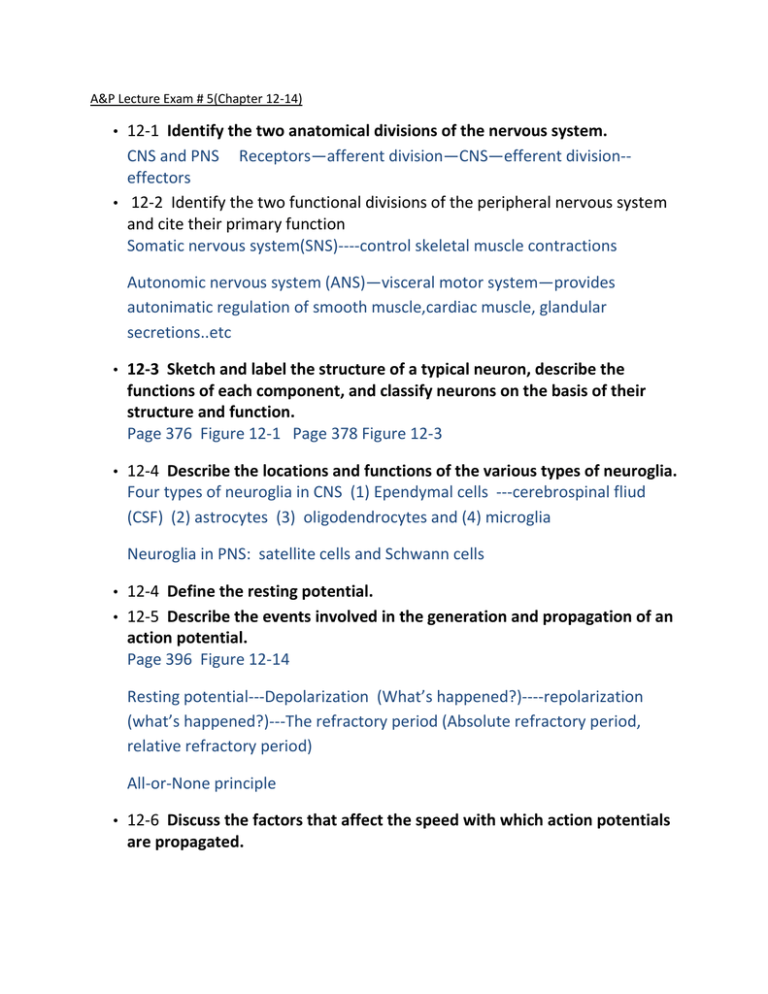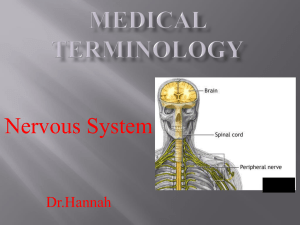Exam5review.doc
advertisement

A&P Lecture Exam # 5(Chapter 12-14) • 12-1 Identify the two anatomical divisions of the nervous system. CNS and PNS Receptors—afferent division—CNS—efferent division-effectors • 12-2 Identify the two functional divisions of the peripheral nervous system and cite their primary function Somatic nervous system(SNS)----control skeletal muscle contractions Autonomic nervous system (ANS)—visceral motor system—provides autonimatic regulation of smooth muscle,cardiac muscle, glandular secretions..etc • 12-3 Sketch and label the structure of a typical neuron, describe the functions of each component, and classify neurons on the basis of their structure and function. Page 376 Figure 12-1 Page 378 Figure 12-3 • 12-4 Describe the locations and functions of the various types of neuroglia. Four types of neuroglia in CNS (1) Ependymal cells ---cerebrospinal fliud (CSF) (2) astrocytes (3) oligodendrocytes and (4) microglia Neuroglia in PNS: satellite cells and Schwann cells • 12-4 Define the resting potential. • 12-5 Describe the events involved in the generation and propagation of an action potential. Page 396 Figure 12-14 Resting potential---Depolarization (What’s happened?)----repolarization (what’s happened?)---The refractory period (Absolute refractory period, relative refractory period) All-or-None principle • 12-6 Discuss the factors that affect the speed with which action potentials are propagated. • 13-1 Define the component of the central nervous system and of the peripheral nervous system CNS (Brain and spinal cord) ; PNS (cranial nerves and spinal nerves) • 13-2 Discuss the structure and functions of the spinal cord, and describe the three meningeal layers that surround the central nervous system. Gray matter , white matter, Dorsal root, ventral root, dorsal root ganglion, Menings (Pia matter, Arachnoid matter, Dura matter) Subarachnoid space fill with cerebral fliud (CSF) • 13-3 Explain the roles of white matter and gray matter in processing and relaying sensory information and motor commands. Page 423 figure 13-5 a • 13-4 Describe the steps in a neural reflex, and classify the types of reflexes. The reflex arc, Classification of reflexes (Page 437 figure 13-16) • 13-7 Distinguish among the types of motor responses produced by various reflexes, and explain how reflexes interact to produce complex behaviors. • 14-1 Name the SIX major brain regions, FOUR ventricles PAGE 449 Figure 14-1 PAGE 451 FIGURE 14-2 • 14-2 What brain regions make up the brain stem? Diencephalon (Thalamus, hypothalamuse); midbrain; pons; medulla oblongata • 14-3 Explain how the brain is protected and supported, and discuss the formation, circulation, and function of cerebrospinal fluid. Cranial menings, Cerebrospinal fliud, the blood-brain barrier. • 14-4 Identify the components of the medulla oblongata that are • • • • responsible for the relaying somatic sensory information to the thalamus. 14-5 The medulla oblongata is one of the smallest sections of the brain, yet damages there can cause death, whereas similar damage in the cerebrum might go unnoticed. Why? 14-5 what’d the function of thalamus and hypothalamus? 14-6 List the main components of the cerebellum, and specify the functions of each. 14-7 Identify the major anatomical subdivisions and functions of the cerebrum, and discuss the origin and significance of the major types brain waves seen in an electroencephalogram. Cerebral cortex ; central sulcus; precentral gyrus; postcentral gyrus etc. Page 473 Figure 14-15 • 14-10 Describe representative examples of 12 pairs of cranial reflexes





